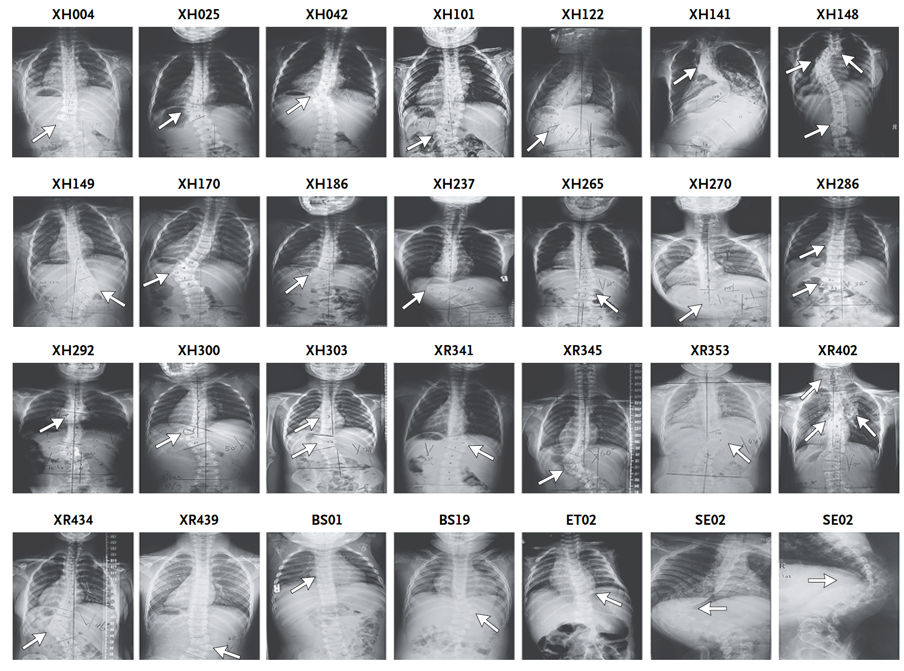HOME > WHAT IS DISCO STUDY > Introduction of scoliosis
Introduction of Scoliosis
Scoliosis is a medical condition in which a patients’ spine has a sideways curve. The curve is usually “S”- or “C”-shaped. There are many conditions that could result in scoliosis, including congenital vertebral malformations, idiopathic (with unknown etiology) one, neuromuscular problems, inherited disorders, or conditions caused by environmental factors.
The population frequency of scoliosis is about 3-5%. An estimated 65% of scoliosis cases are idiopathic, about 15% are congenital and about 10% are secondary to a neuromuscular disease.
Idiopathic scoliosis represents a majority of cases while its causes are largely unknown, presented as simply a spinal curve without vertebral malformations. Adolescent idiopathic scoliosis (AIS) has no clear causes and is generally believed to be multifactorial. The prevalence of scoliosis is 1% to 2% among adolescents, and it often presents during an adolescent‘s growth spurt and is more often diagnosed in females than males. Several candidate-gene and genome-wide association studies (GWAS), as well as genetic linkage, have been conducted, in which several associated loci were identified.

Congenital Scoliosis (CS) is a congenital deformity of the spine presented as a spinal curve with vertebral malformations in a prevalence of 0.5-1‰, which contributes significantly to morbidity and mortality. It can also accompany other organic deformities, for instance renal, cardiac, or intra-spinal defects. CS is characterized by severe deformities, rapid progression, and 30-60% of which with multiple comorbidities, compromising pulmonary function and causing paralysis, which gives rise to a significant impact on both physical and psychological health of the patients. The high cost of CS treatment renders a heavy burden to both the families and the whole society. Up to now, the compound heterozygous model of TBX6 (a rare null variant compound with a common hypomorphic allele) accounts for the most important genetic causes of worldwide CS sporadic patients.
Secondary scoliosis is mainly caused by neuropathy or myopathy, which can lead to an impaired function of muscular support for the spinal column so that the spinal column is pulled in abnormal directions. Some conditions which may cause secondary scoliosis include muscular dystrophy, spinal muscular atrophy, poliomyelitis, cerebral palsy, spinal cord trauma, myotonia, etc.
Scoliosis associated with known syndromes is often sub-classified as “syndromic scoliosis”. Patients with those syndromes share scoliosis and are different from each other in associated systemic phenotypes, i.e. Klippel-Feil syndrome (KFS), Alagille syndrome (ALGS), and VACTERL Association, etc.
Early-onset scoliosis (EOS) is defined as a curvature of the spine in children >10° with onset before age 10 years. Young children with EOS are at risk for impaired pulmonary function because of the high risk of progressive spinal deformity and thoracic constraints during a critical time of lung development. The treatment of EOS is very challenging because the patients with EOS often medically complex, and often need multiple surgeries. In the past, early spinal fusion was performed in children with severe progressive EOS, which corrected scoliosis but limited spine and thoracic growth and resulted in poor pulmonary outcomes. The current goal in the treatment of EOS is to maximize the growth of the spine and thorax by controlling the spinal deformity, with the aim of promoting normal lung development and pulmonary function. However, the treatment of early-onset scoliosis (EOS) remains a challenging and rapidly evolving area of pediatric orthopedics.
